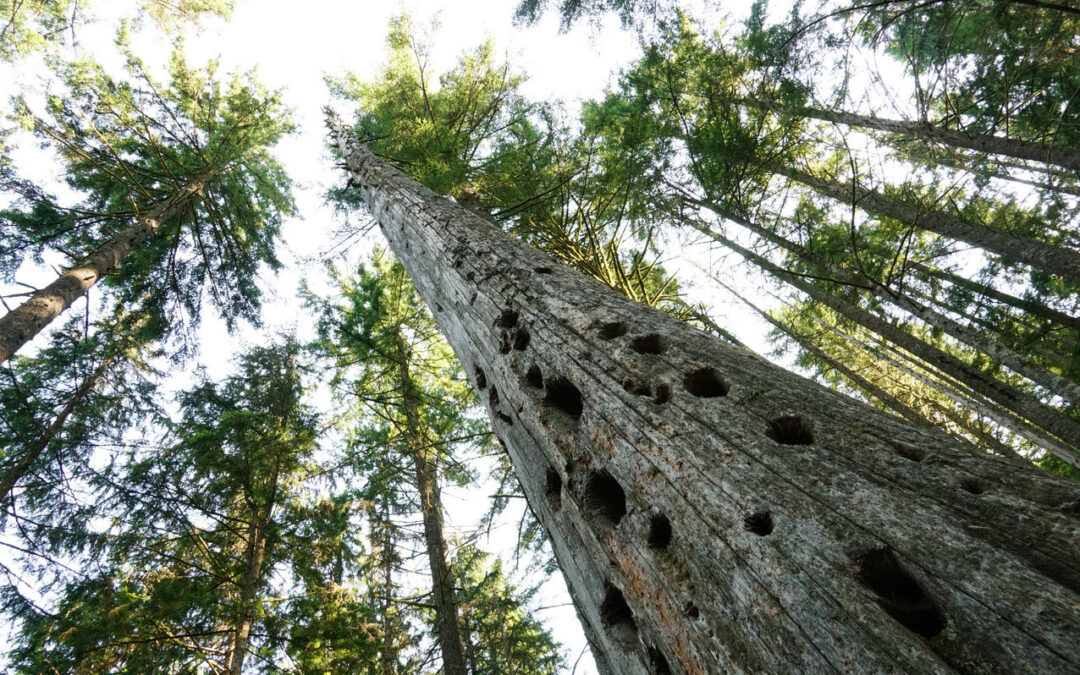DNR Seeks to Clearcut 90-Year Old Legacy Forest to Improve its “Health”
|
|
|
DNR is attempting to use naturally occuring tree mortality — a common feature of mature and old growth forests that creates habitat for dozens of small mammal and bird species — as an excuse to lift logging prohibitions instituted by Commissioner Upthegrove. If this project is allowed to proceed, it could open the door to the logging of other legacy forests.
|
|
|
The Firvana timber sale would clearcut the entire Gold Creek Legacy Forest.
|
|
|
A rare, ecologically diverse 60-acre legacy forest in Kitsap County is under immediate threat. The Gold Creek Legacy Forest grew back after a wildfire scorched the slopes of Gold Mountain over a century ago. Today, it contains a mosaic of different plant communities, fire-scarred old growth snags, and trees species of different shapes and sizes. It’s home to a wide variety of cavity-nesting birds, small mammals, and probably bats, and sits directly above the popular Tin Mine Trail in Green Mountain State Forest. Recognizing the value of this unique forest, the Kitsap County Board of Commissioners has identified the Gold Creek Legacy Forest as a priority conservation area, and requested that the Firvana timber sale be paused so that options to preserve this area can be explored.
The Firvana timber sale had been postponed in January as part of the temporary moratorium on the logging of structurally complex forests instituted by newly elected Public Lands Commissioner Upthegrove. The Washington Department of Natural Resources (DNR) as now reversed course and is moving forward with its plans to clearcut the Gold Creek Legacy Forest.
|
|
|
DNR claims the forest is “falling apart” and needs to be logged to rid it of fungal pathogens, parasites, and defoliating insects. If DNR’s goal is to manage the land to produce high quality, commercial-grade timber, then it might seem reasonable to extract as much value as possible from the stand by logging it now and replanting it with nursery-grown tree seedlings. From an ecological perspective, logging this forest would be disastrous. In natural forests, tree species have co-evolved with many antagonistic species. These forests have built-in defense mechanisms for controlling the spread of defoliators, bark beetles, root pathogens and parasites, and recover more quickly following outbreaks. Importantly, these natural agents of disturbance play a critical role in the successional process — creating standing dead trees and canopy openings that allow shade tolerant tree species like hemlock and cedar to emerge from the understory.
|
|
|
During recent field surveys, LFDC documented seven species of old-forest-dependent birds actively using the stand—including the Golden-crowned Kinglet, a species that has declined by over 91% in the Puget Sound region since 1968, largely due to habitat loss. These birds depend on mature interior forest conditions—exactly the type of habitat Firvana provides.
The proposed timber sale would destroy this forest and its structural, genetic, and biological legacies, and replace it with a plantation of Western White Pine and Western Red Cedar. This legacy forest, which is naturally resilient to disease and outbreaks of defoliating insects, provides vital habitat that cannot be replicated by managed tree farms.
|
|
|
The Firvana Timber Sale and Gold Creek Beaver Ponds from the air.
|
|
|
The DNR’s plan to “reset” Firvana by clearcutting it prioritizes timber production over wildlife habitat. It also undermines DNR’s ability to meet its legal commitment to protect and restore mature and old growth forests, as outlined in numerous planning documents, including the State Lands Habitat Conservation Plan, 2004 Sustainable Harvest FEIS, and 2006 Policy for Sustainable Forests.
|
|
|
The innocuous conk responsible for much of the claimed “forest health crisis” in the Firvana timber sale (left) and the Golden-crowned Kinglet (right.)
|
|
|
Its own HCP calls on DNR to protect and restore structurally complex forests across 25-35% of state forest lands in Western Washington, and protect and restore old growth conditions across 10-15%. Yet the agency is farther from meeting these objectives today than when the HCP was adopted. In the South Puget Sound region, nearly all fully functional forests are gone, and DNR is far from meeting its own milestones, established in 2004, for protecting and restoring structurally complex forests across 18% of state forest lands in Western Washington by 2013, and 21% by 2031.
Clearcutting Firvana moves us in the wrong direction—away from recovery, away from biodiversity, and away from a future where native forests and the species that depend on them can thrive.
We urge the DNR to honor its legal commitment to conserve and restore structurally complex forests across Western Washington, and cancel the Firvana timber sale.
|
|
|
The public has until 6pm on May 6 to submit comments to DNR.
If you’d like to make your voice heard with a personalized comment, you can submit your comment here.
If you live in Kitsap County, please consider reaching out to your county commissioner thanking them for supporting the conservation of Green Mountain’s Legacy Forests.
|
|
|
Old growth snag in the Firvana timber sale riddled with dozens of woodpecker holes. For decades, this tree has provided ideal nesting habitat for a variety of small mammals, woodpeckers, bats, and cavity nesting birds. These snags are inevitably removed during logging operations because they are considered safety hazards.
|
|
|
If you support our work, consider making a donation.
All donations are tax deductible.
|
|
|
The Legacy Forest Defense Coalition is a registered 501(c)(3) public nonprofit charity based in Washington State.
|
|
|
|
|









